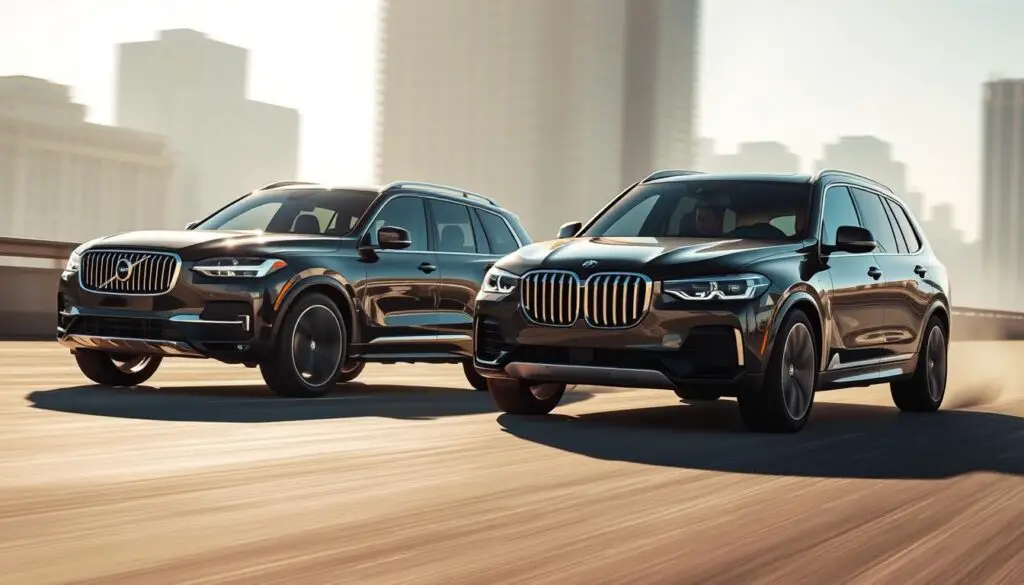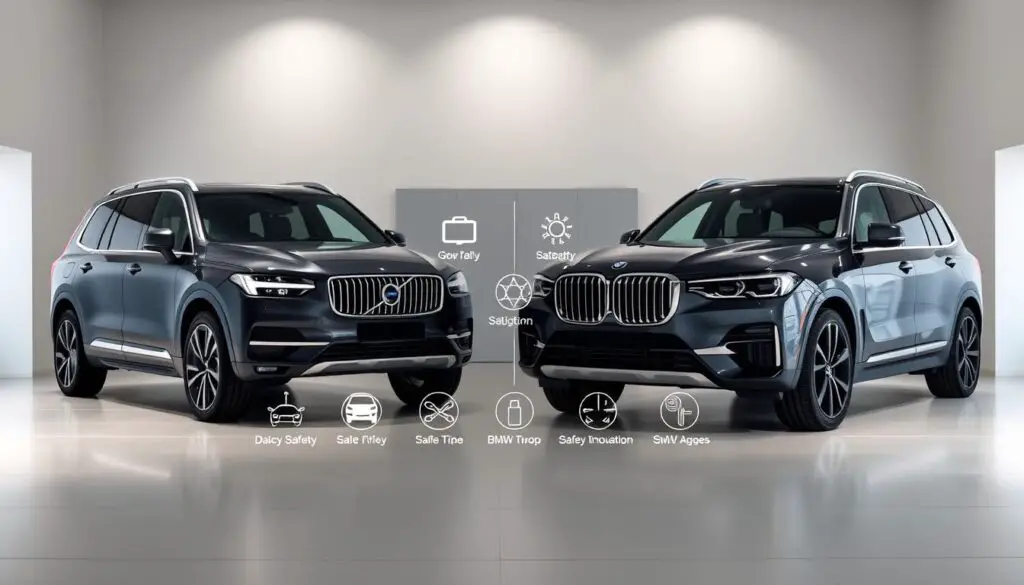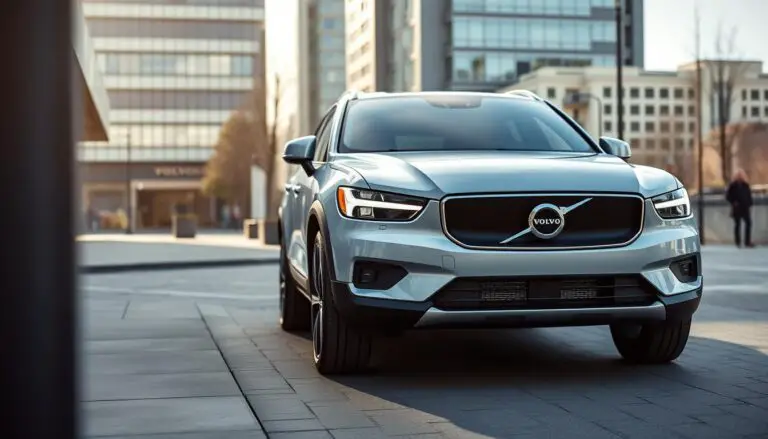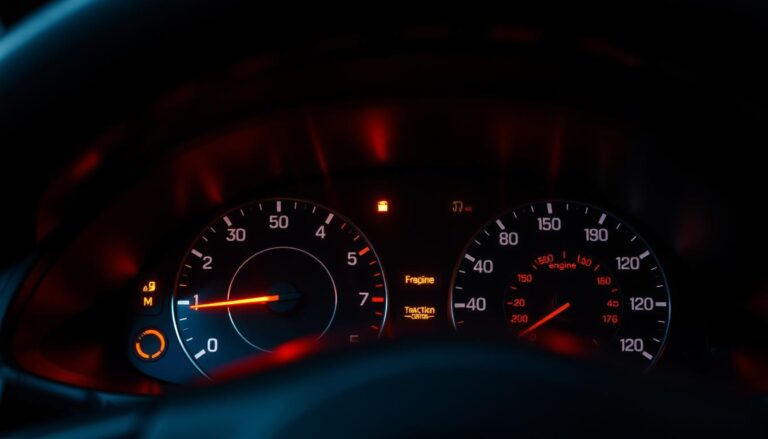The luxury SUV market is heating up with two formidable contenders: the Volvo XC90 and the BMW X7. Both vehicles have garnered attention for their exceptional performance, advanced safety features, and opulent interiors.
As we dive into this head-to-head comparison, it becomes clear that these SUVs cater to different needs and preferences. The Volvo XC90 is renowned for its emphasis on safety and Scandinavian design, while the BMW X7 boasts a powerful engine and a lavish driving experience.
This comparison aims to dissect the strengths and weaknesses of each model, helping you make an informed decision when choosing your next luxury SUV.
Key Takeaways
- Luxury SUVs offer advanced safety features and premium interiors.
- The Volvo XC90 excels in safety and design.
- The BMW X7 provides a powerful engine and luxurious driving experience.
- Both vehicles cater to different needs and preferences.
- A detailed comparison is essential for making an informed decision.
The State of Luxury SUVs in the American Market
The luxury SUV market in the United States is witnessing a surge in demand, with brands like Volvo and BMW vying for dominance. This growing demand is driven by consumer preferences for premium features, advanced technology, and versatile performance capabilities.
Premium SUV Trends and Consumer Preferences
Consumers in the U.S. are increasingly leaning towards luxury SUVs that offer a blend of style, comfort, and technological innovation. Key trends include the demand for advanced safety features, electrification, and luxurious interiors. The preference for SUVs over traditional sedans is also driven by their versatility and perceived safety.
Volvo and BMW’s Market Positioning
Volvo and BMW have positioned themselves uniquely in the luxury SUV market. Volvo is known for its emphasis on safety and sustainable mobility, while BMW focuses on performance and dynamic driving experiences. The Volvo XC90 is celebrated for its minimalist design and advanced safety features, whereas the BMW X7 is recognized for its bold luxury statement and powerful performance capabilities.
Volvo XC90 vs BMW X7: Direct Comparison Overview
In the realm of luxury SUVs, the Volvo XC90 and BMW X7 stand out as top contenders. Both vehicles offer a unique blend of style, performance, and technology, making them highly sought after in the American market.
Volvo XC90 Key Specifications
The Volvo XC90 is known for its sleek design and robust capabilities. Key specifications include:
- Engine: Turbocharged and supercharged 2.0-liter 4-cylinder engine
- Horsepower: Up to 316 horsepower
- Transmission: 8-speed automatic
- Drive Type: All-wheel drive
Dimensions: The Volvo XC90 has a length of 195.7 inches, a width of 75.2 inches, and a height of 69.7 inches.
BMW X7 Key Specifications
The BMW X7 is celebrated for its opulent interior and powerful performance. Key specifications include:
- Engine: Twin-turbo 3.0-liter 6-cylinder engine
- Horsepower: Up to 375 horsepower
- Transmission: 8-speed automatic
- Drive Type: All-wheel drive
Dimensions: The BMW X7 has a length of 204.3 inches, a width of 78.7 inches, and a height of 70.7 inches.
| Specification | Volvo XC90 | BMW X7 |
|---|---|---|
| Engine Type | Turbocharged & Supercharged 4-Cylinder | Twin-Turbo 6-Cylinder |
| Horsepower | Up to 316 hp | Up to 375 hp |
| Length (inches) | 195.7 | 204.3 |
Design Philosophy and Exterior Aesthetics
The exterior aesthetics of the Volvo XC90 and BMW X7 reflect their underlying design philosophies, setting them apart in the luxury SUV market. The Volvo XC90 embodies a minimalist Scandinavian design, while the BMW X7 makes a bold luxury statement.
Volvo’s Scandinavian Minimalism
Volvo’s design philosophy is characterized by clean lines, simplicity, and a focus on functionality. The XC90’s exterior is a testament to this, with its distinctive Thor’s Hammer LED headlights and a sleek, aerodynamic profile. This minimalist approach gives the XC90 a timeless appeal that resonates with those who value understated luxury.
BMW’s Bold Luxury Statement
In contrast, the BMW X7 makes a bold statement with its exterior design. Featuring a large kidney grille and slim LED headlights, the X7 exudes a sense of grandeur and presence on the road. The X7’s design is more aggressive and attention-grabbing, appealing to those who prefer a more assertive luxury SUV.
Size, Proportions, and Road Presence
Both SUVs are substantial in size, but their proportions and road presence differ. The Volvo XC90 is known for its compact, yet spacious design, while the BMW X7 is larger and more imposing.
Wheelbase and Dimensional Comparison
The BMW X7 has a longer wheelbase than the Volvo XC90, contributing to its larger interior space. However, the XC90’s dimensions are more compact, making it easier to maneuver in tight spaces.
Design Elements That Stand Out
Key design elements that stand out include the XC90’s angular lines and the X7’s flared fender. These features not only enhance their visual appeal but also contribute to their unique identities in the luxury SUV segment.
Interior Luxury and Comfort Features
The interior of a luxury SUV is a reflection of its overall quality, and both the Volvo XC90 and BMW X7 excel in this regard. As we delve into the details of their interior luxury and comfort features, it becomes clear that both vehicles have their strengths.
Materials, Craftsmanship, and Build Quality
The Volvo XC90 is renowned for its premium materials and meticulous craftsmanship. The interior features a range of high-quality materials, including premium leather upholstery and meticulously crafted wooden trim. Similarly, the BMW X7 boasts luxurious interiors with advanced materials and a focus on build quality.
Seating Configurations and Passenger Space
Both SUVs offer versatile seating configurations to accommodate passengers comfortably. The Volvo XC90 provides ample space for up to 7 passengers, depending on the configuration.
Front Seat Experience
The front seats in both vehicles are designed to offer maximum comfort, with features like heated and ventilated seats and massage functions available in higher trims.
Second and Third Row Comfort
The second row in both SUVs is spacious, with generous legroom. The third row, while somewhat cramped in both vehicles, is still accessible and suitable for occasional use.
Cargo Capacity and Practical Utility
Cargo capacity is a crucial aspect of any SUV. The Volvo XC90 offers a competitive cargo space, with up to 85.7 cubic feet of cargo capacity available. The BMW X7, with its larger size, provides up to 90.4 cubic feet of cargo space, making it a more practical choice for those needing ample storage.
In conclusion, both the Volvo XC90 and BMW X7 offer luxurious interiors with a focus on comfort and practicality. The choice between them will depend on specific needs and preferences regarding interior features and overall comfort.
Technology and Infotainment Capabilities
As luxury SUV buyers increasingly prioritize tech-savvy features, the Volvo XC90 and BMW X7 are stepping up their game with innovative infotainment solutions. This section delves into the technological advancements of both vehicles, comparing their infotainment systems, digital displays, sound systems, and other tech features.
Volvo Sensus Connect vs BMW iDrive 7.0
The Volvo Sensus Connect and BMW iDrive 7.0 are the heart of their respective vehicles’ infotainment capabilities. While both systems are highly advanced, they have distinct approaches to user experience.
Interface Design and Usability
The Volvo Sensus Connect is renowned for its intuitive interface, making it easy for drivers to navigate through various functions without being distracted from the road. In contrast, BMW iDrive 7.0 boasts a more complex yet customizable interface, allowing users to personalize their experience.
Connectivity and App Integration
Both systems offer seamless connectivity and app integration. The Volvo Sensus Connect supports Apple CarPlay and Android Auto, ensuring drivers have access to their favorite apps. Similarly, BMW iDrive 7.0 offers comprehensive connectivity options, including wireless Apple CarPlay.
Digital Displays, Sound Systems, and Tech Features
Beyond their core infotainment systems, both SUVs are equipped with impressive digital displays and sound systems. The Volvo XC90 features a 9-inch screen and an optional Harman Kardon sound system, while the BMW X7 offers a range of display options, including a 12.3-inch digital instrument cluster, and an elite version of the Harman Kardon sound system.
Performance and Driving Experience
For those seeking a luxurious driving experience, the Volvo XC90 and BMW X7 are two premier SUVs that warrant a closer look at their performance attributes. Both vehicles are engineered to deliver exceptional driving dynamics, but they achieve this in different ways.
Engine Options, Horsepower, and Torque
The Volvo XC90 offers a range of engine options, including a 2.0-liter turbocharged inline-4 and a hybrid variant that combines a supercharged and turbocharged 4-cylinder with an electric motor. The BMW X7, on the other hand, is powered by a 3.0-liter turbocharged inline-6 and offers a more powerful 4.4-liter twin-turbo V8 in its top trim.
| SUV Model | Engine Type | Horsepower | Torque (lb-ft) |
|---|---|---|---|
| Volvo XC90 | 2.0L Turbocharged I4 | 250 | 258 |
| BMW X7 xDrive40i | 3.0L Turbocharged I6 | 335 | 369 |
| BMW X7 xDrive50i | 4.4L Twin-Turbo V8 | 523 | 553 |
Handling, Suspension, and Ride Quality
The Volvo XC90 is known for its agile handling and responsive steering, thanks in part to its adaptive suspension and all-wheel-drive system. The BMW X7 also features an adaptive suspension and all-wheel drive, providing a comfortable ride and capable handling.
“The XC90’s handling is remarkably agile for its size, making it a joy to drive on twisty roads.” –
All-Wheel Drive Systems and Capability
Both SUVs come equipped with sophisticated all-wheel-drive systems. The Volvo XC90 features a Haldex Gen 5 all-wheel-drive system, while the BMW X7 boasts xDrive technology. These systems enhance traction, stability, and control, making both vehicles capable in a variety of driving conditions.

In conclusion, both the Volvo XC90 and BMW X7 offer compelling performance and driving experiences. The choice between them will depend on the driver’s priorities regarding engine power, handling, and overall driving dynamics.
Fuel Economy and Environmental Considerations
In the luxury SUV segment, fuel economy and environmental considerations are becoming key differentiators. As consumers become more environmentally conscious, the onus is on manufacturers like Volvo and BMW to innovate and reduce the ecological footprint of their vehicles.
Volvo’s Hybrid and Electrification Strategy
Volvo has been at the forefront of electrification, with a clear strategy to make all its models electric by 2030. The Volvo XC90 already offers a plug-in hybrid model, providing improved fuel economy and reduced emissions. This move towards electrification not only enhances the vehicle’s environmental credentials but also offers consumers a more sustainable luxury option.
BMW’s Efficiency Technologies
BMW has also been investing in efficiency technologies, including its eDrive system for plug-in hybrid models like the X7 xDrive50e. This system combines a powerful engine with an electric motor, significantly improving fuel economy and reducing CO2 emissions. BMW’s approach to efficiency is multifaceted, including aerodynamic design improvements and lightweight construction.
EPA Ratings and Real-World Consumption
The EPA ratings for the Volvo XC90 and BMW X7 vary based on the specific model and drivetrain. For instance, the Volvo XC90 T6 plug-in hybrid has an EPA rating of up to 27 mpg combined, while the BMW X7 xDrive50e achieves up to 21 mpg combined. Real-world consumption can differ, influenced by factors like driving habits and conditions.
Environmental Impact Beyond MPG
Beyond fuel economy, the overall environmental impact of these vehicles includes production emissions and the source of their electricity. Volvo’s commitment to using recycled materials and reducing waste in production further enhances its environmental credentials. Similarly, BMW’s use of sustainable materials and recycling programs contributes to a more circular economy.
Safety Features, Innovation, and Ratings
The Volvo XC90 and BMW X7 are renowned for their commitment to safety, boasting an array of sophisticated safety technologies. Both vehicles have a strong reputation for protecting occupants and preventing accidents.
Volvo’s Safety Heritage and Technologies
Volvo has a long history of prioritizing safety, with innovations such as the three-point seatbelt and advanced driver-assistance systems (ADAS). The XC90 features a comprehensive suite of safety features, including City Safety (automatic emergency braking), Pilot Assist (semi-autonomous driving), and Run-Off Road Protection.
BMW’s Safety Systems and Driver Assistance
BMW has also made significant strides in safety technology, with the X7 offering features like Active Cruise Control, Lane Departure Warning, and Automatic Emergency Braking. The X7’s safety suite is designed to enhance driver awareness and prevent accidents.
IIHS and NHTSA Ratings Comparison
Both vehicles have received high safety ratings from reputable organizations. The Volvo XC90 has been named a Top Safety Pick+ by the IIHS, while the BMW X7 has also received high ratings. The table below compares their safety ratings:
| Organization | Volvo XC90 Rating | BMW X7 Rating |
|---|---|---|
| IIHS | Top Safety Pick+ | Top Safety Pick+ |
| NHTSA | 5-Star Overall | 5-Star Overall |

In conclusion, both the Volvo XC90 and BMW X7 demonstrate exceptional safety credentials, with advanced features and high ratings from respected safety organizations.
Pricing Structure and Ownership Value
The pricing and ownership costs of the Volvo XC90 and BMW X7 are key factors in determining which luxury SUV offers the best value.
Base MSRP and Trim Level Comparison
The Volvo XC90 starts at around $54,000 for the base model, while the BMW X7 begins at approximately $68,000. The trim levels for both vehicles offer various upgrades.
- Volvo XC90: Core, Plus, and Excellence trims
- BMW X7: xDrive40i, xDrive50i, and M50i trims
The Volvo XC90 offers a more straightforward trim progression, whereas the BMW X7 provides a broader range of options.
Popular Options and Package Pricing
Both vehicles offer a range of optional packages that can significantly impact the final price.
- Volvo XC90’s Premium Plus package: adds advanced safety features
- BMW X7’s Luxury Package: enhances interior comfort
Pricing for these packages can add up to $10,000 or more, depending on the choices made.
Maintenance Costs, Warranty, and Depreciation
Maintenance costs for both vehicles are relatively similar, with the Volvo XC90 estimated to be slightly more affordable over the first five years.
- Warranty coverage: Volvo and BMW offer competitive warranties
- Depreciation rates: differ between the two models
Understanding these factors is crucial for assessing the overall ownership value.
Ideal Buyer Profile: Which SUV Is Right for You?
Both the Volvo XC90 and BMW X7 cater to different buyer personas, each with unique characteristics and needs. Understanding these profiles can help potential buyers determine which luxury SUV best suits their lifestyle and preferences.
The Volvo XC90 Owner Persona
The ideal buyer for the Volvo XC90 is likely someone who prioritizes safety, design, and family-friendly features. This persona values:
- Advanced safety features and a strong safety record
- Scandinavian design and minimalist aesthetics
- Comfort and spaciousness for passengers
- Environmental sustainability and fuel efficiency
For instance, a family with young children might appreciate the Volvo XC90’s integrated booster seats and comprehensive safety suite, making it an attractive option for those who prioritize their family’s well-being.
The BMW X7 Owner Persona
In contrast, the BMW X7 appeals to a different demographic, typically those who value:
- Luxury and premium materials
- Performance and driving dynamics
- Technology and infotainment capabilities
- Status symbol and brand prestige
For example, a successful professional might be drawn to the BMW X7’s powerful engine options and advanced iDrive system, enjoying the blend of performance and luxury.
| Characteristics | Volvo XC90 | BMW X7 |
|---|---|---|
| Priorities | Safety, Design, Family | Luxury, Performance, Technology |
| Target Audience | Families, Safety-conscious | Successful Professionals, Tech Enthusiasts |
By understanding these buyer profiles, potential owners can make an informed decision that aligns with their needs and preferences, ensuring they choose the luxury SUV that best fits their lifestyle.
Conclusion: The Verdict on These Luxury Titans
The Volvo XC90 and BMW X7 represent two different philosophies in the luxury SUV segment. The Volvo XC90 vs BMW X7 comparison reveals that Volvo’s focus on safety, minimalist design, and electrification appeals to those prioritizing practicality and environmental considerations.
In contrast, the BMW X7, with its bold exterior, powerful engine options, and advanced infotainment system, caters to buyers seeking a more dynamic driving experience and a statement piece on the road. When considering a luxury SUV comparison, the choice between these models depends on individual priorities.
Ultimately, the Volvo XC90 is ideal for families or those valuing understated luxury and advanced safety features, while the BMW X7 is suited for drivers who crave performance, premium tech, and a commanding presence. Both vehicles excel in their respective areas, making the decision a matter of personal preference.
FAQ
What are the key differences between the Volvo XC90 and BMW X7?
The Volvo XC90 and BMW X7 differ significantly in design philosophy, with the Volvo XC90 embodying Scandinavian minimalism and the BMW X7 making a bold luxury statement. Additionally, they vary in engine options, interior luxury features, and safety technologies.
How do the Volvo XC90 and BMW X7 compare in terms of safety features?
Both vehicles are equipped with advanced safety features. The Volvo XC90 is renowned for its safety heritage, featuring technologies like City Safety and Pilot Assist. The BMW X7 also offers a range of safety systems, including its Driving Assistance Professional package. Both vehicles have received high safety ratings from IIHS and NHTSA.
What are the engine options available for the Volvo XC90 and BMW X7?
The Volvo XC90 offers a range of engine options, including a turbocharged and supercharged inline-4 engine, as well as a hybrid variant. The BMW X7 provides several engine options, including inline-6 and V8 configurations, with varying levels of horsepower and torque.
How do the Volvo XC90 and BMW X7 compare in terms of fuel economy?
The Volvo XC90, particularly its hybrid variant, offers competitive fuel economy. The BMW X7, with its range of engine options, varies in fuel efficiency. The EPA ratings and real-world consumption can differ significantly between the two models, depending on the specific configuration.
What are the pricing structures for the Volvo XC90 and BMW X7?
The base MSRP for the Volvo XC90 and BMW X7 differs, with the Volvo XC90 generally positioned as a more affordable luxury SUV option. The BMW X7, with its range of engine options and luxury features, can escalate in price, especially when opting for higher trim levels and additional features.
How do the Volvo XC90 and BMW X7 compare in terms of interior luxury and comfort?
Both vehicles offer luxurious interiors, but they differ in approach. The Volvo XC90 is known for its minimalist, Scandinavian design and emphasis on comfort and practicality. The BMW X7 features a more opulent interior, with a focus on premium materials and advanced technology features.
What are the ideal buyer profiles for the Volvo XC90 and BMW X7?
The ideal buyer for the Volvo XC90 tends to value safety, practicality, and Scandinavian design. The BMW X7 appeals to buyers seeking a bold luxury statement, advanced technology, and a range of powerful engine options.
How do the Volvo XC90 and BMW X7 compare in terms of cargo capacity and practical utility?
Both SUVs offer significant cargo space, but the BMW X7, with its larger size, generally provides more cargo capacity, especially with the third row folded. The Volvo XC90 is also practical, with a spacious interior, but its cargo capacity is slightly less than the BMW X7.



